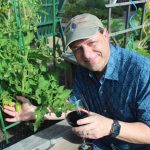OCEANSIDE — For nearly six years, Jim Gonzales has been battling a rare, advanced form of cancer. After finally finding a drug that stopped the mass in his abdomen from growing, the COVID-19 pandemic shook things up for Gonzales.
Gonzales, 52, has a rare and potentially deadly sarcoma roughly about the size of a volleyball in his abdomen. Sarcoma is a type of cancer that can occur in various places of your body and begin in the bones and soft tissues. For Gonzales, the sarcoma developed in soft tissue.
Gonzales has gone through multiple treatments, has had two major surgeries and has had more than 20 tumors removed over the past six years.
“The initial one was the size of a football,” Gonzales said.
Nothing was stopping the mass from growing until October 2019 when Gonzales became a subject in the first phase of a clinical trial for an experimental drug called ALRN-6924, chemotherapy that targets a specific genetic mutation. For Gonzales, it was considered the last hope.
Gonzales began traveling to MD Anderson Cancer Center in Houston, where the clinical trial was licensed to take place.
Every week, Gonzales would travel 1,400 miles to receive this drug. He would hop on a plane Monday, wake up early in Houston Tuesday, and go through treatment all day before hopefully being back in his Oceanside bed by midnight Wednesday.
Back home Gonzales is a husband and father to two daughters, one in high school and the other a student at MiraCosta College, where Gonzales works as the director of student life.
“I work with students on their college experience outside of the classroom,” he said.
Gonzales has been with MiraCosta College for 25 years. He also recently retired from the Navy Reserve after 26 years of service.
To be able to make the nearly $1,000 weekly trip to Houston from Oceanside, Gonzales said the family had to make some “major financial maneuvers.”
The expensive and exhausting weekly trips were worth it to Gonzales though because the drug was working. It had stopped the growth of the mass, thus stabilizing his disease.
Then COVID-19 happened. In the weeks leading up to the stay-at-home orders, Gonzales was concerned about the risk to his health by traveling back and forth between San Diego and Houston as someone with a compromised immune system. Still, he was determined to get the treatment.
Unfortunately, he received the news in March that his treatment in Houston would be stopped. The drug company had halted his clinical trial.
“That was devastating to find out,” Gonzales said.
Without the drug, Gonzales may have had to undergo another, life-altering surgery or possibly not survive the next 12 months.
His doctor in Houston, Dr. Funda Meric-Bernstam, then began working with Dr. Kathryn Bollin, a medical oncologist at Scripps MD Anderson Cancer Center in San Diego, to bring Gonzales’s treatment there.
According to Bollin, there was a team of around 30 people who worked to make the switch happen. They were able to gain compassionate use approval from the Federal Drug Administration (FDA) for the use of the drug, something Bollin said is uncommon, and the drug company agreed to provide the drug for Jim’s therapy for free.
This also established the San Diego location as a new treatment site for investigational therapy with the drug.
After going nearly two months without treatment, Gonzales resumed his treatments at Scripps MD Anderson on May 5. This includes an ongoing three weeks on and one-week-off cycle of IV once-a-week IV treatments, all of which are just 30 minutes away in San Diego.
“The drug is working, there is no question,” she said.
Bollin confirmed that the mass has not grown since it stopped in March.
Chemotherapy can be incredibly difficult for patients to endure. Gonzales has gone through his own fair share of rough chemo treatments and has even ended up hospitalized because of one.
Bollin said Gonzales is fortunate for how well he is tolerating the treatment, which becomes more difficult to endure with time. She also said Gonzales has been able to maintain an “excellent quality of life” while undergoing the treatment, and he agreed.
Gonzales experiences some nausea and fatigue with this treatment, but those are nothing compared to his previous treatments’ side effects. Plus, he doesn’t have to deal with traveling anymore.
“My quality of life is so much better without the added burden of travel,” he said.
Even with the COVID-19 hurdle, everything worked out “in a weird way” for Gonzales in the end.
“I’m very blessed,” he said.




1 comment
Wow Praying for you! Courage. I am in my 9th year of metastatic bone cancer. I understand. We keep living and smelling the roses. ???
Comments are closed.